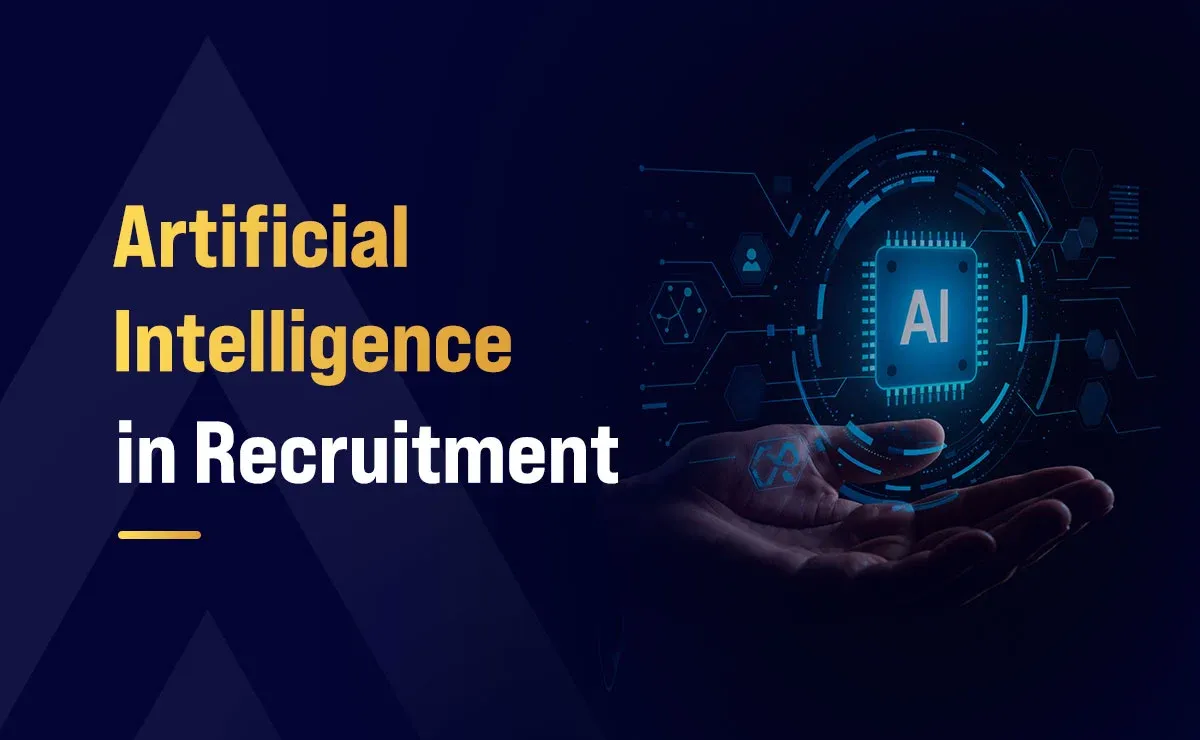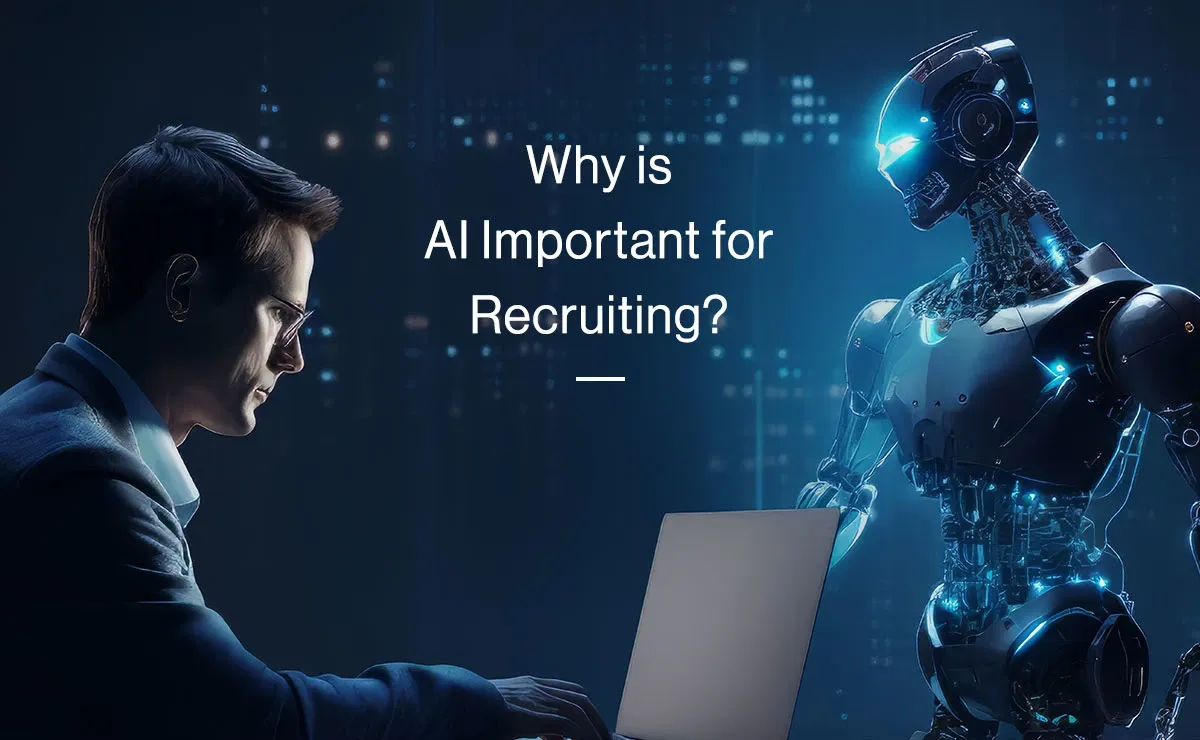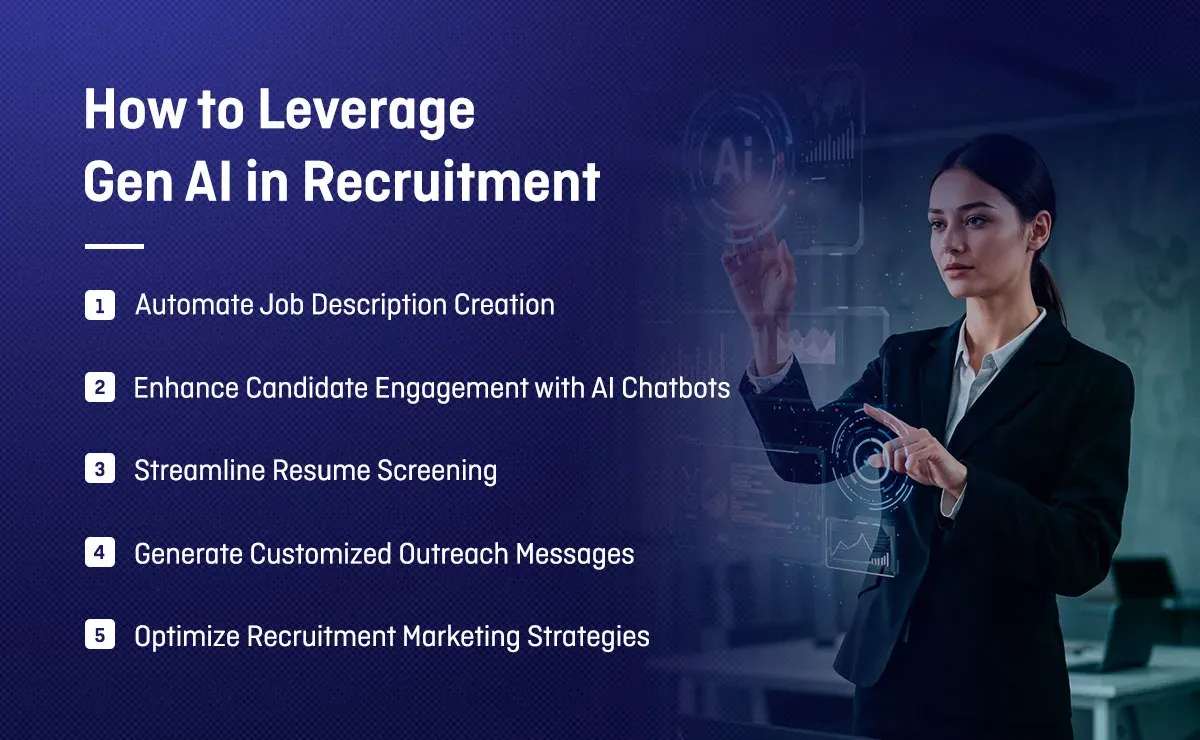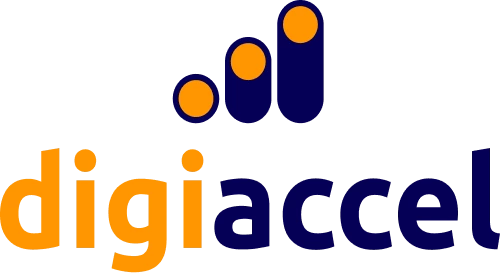Artificial Intelligence in Recruitment

Attracting and keeping skilled professionals is harder than ever in today's global job market. For businesses, this ability is crucial for staying ahead of the competition. Recruiters frequently face an overwhelming number of applications for job openings.
In fact, 52% say that sifting through these large groups of candidates is the hardest part of their job. This puts a significant strain on human resources, showing a clear need for new solutions to make recruitment processes more efficient and effective. This is where artificial intelligence (AI) has emerged as a vital technology that can transform how organizations manage their talent.
AI can automate routine tasks, provide much deeper insights into which candidates are truly suitable, and help companies make hiring decisions that are faster and more equitable. This article will explore how AI is changing recruitment, look at its opportunities and challenges, and offer practical advice for businesses planning to use AI in their hiring strategies.
The Difference Between Artificial Intelligence & Machine Learning
Artificial intelligence (AI) involves computer systems engineered to execute functions that traditionally demand human cognition, including judgment calls, language comprehension, and detecting trends.
Machine learning (ML), a branch of AI, centers on algorithms that identify trends and correlations within datasets. Rather than relying on explicit programming for every scenario, ML models “train” on examples and adapt their behavior to improve future performance.
Here’s are the key aspect of differentiation between AI and ML:
Aspect | Artificial Intelligence (AI) | Machine Learning (ML) |
Primary Goal | The goal of AI is to build machines or software that can simulate broad human cognitive functions—reasoning, perception, decision-making, and problem-solving. | The goal of ML is to develop algorithms that can automatically learn from and adapt to data, optimizing their accuracy in performing specific tasks. |
Scope of Application | AI encompasses a wide range of techniques—rule-based systems, expert systems, natural language processing, robotics, and ML—applied across diverse, complex tasks. | ML focuses narrowly on creating predictive or descriptive models for well-defined problems, such as classification, regression, or clustering. |
Data Requirements | AI systems can work with structured, semi-structured, and unstructured data, integrating multiple data modalities (text, images, audio) to mimic human reasoning. | ML systems thrive on large volumes of structured or semi-structured data; they rely on labeled datasets (supervised learning) or patterns in unlabeled data (unsupervised learning). |
Methodology | AI may employ logic, decision trees, search algorithms, or rule engines in addition to statistical learning; it often combines multiple approaches for end-to-end solutions. | ML relies primarily on statistical models and optimization techniques to identify patterns in data, iteratively refining model parameters to reduce prediction errors. |
Adaptability | AI systems can include static rule-based components and adaptive learning components; overall adaptability depends on which subfields (e.g., ML or expert systems) are used. | ML models are inherently adaptive: as more data becomes available, they retrain themselves to improve accuracy on the same specific task. |
Human-likeness | AI aspires to replicate general human intelligence, reasoning across contexts and drawing from world knowledge to tackle varied, novel problems. | ML does not aim for general intelligence; it hones in on learning to perform a single or limited set of tasks exceptionally well by finding statistical patterns. |
Self-Correction | AI systems can include self-correcting loops via feedback but may also require manual updates to their logic or rules in non-learning components. | ML algorithms self-correct by continuously updating their model parameters whenever they are exposed to new training data. |
Examples | A virtual assistant that understands speech, maintains context across conversations, and plans multi-step actions is an AI application. | A spam-filtering system that learns from labeled examples of “spam” and “not spam” and then updates its filtering model as new email arrives is an ML application. |
This table highlights how AI serves as the overarching field striving for human-level problem solving, while ML provides the core learning engines that drive many modern AI capabilities.
Why is AI Important for Recruiting?
Artificial intelligence (AI) is reshaping recruitment from a back-office, administrative grind into a strategic, insight-driven discipline. Here’s why AI matters so much in talent acquisition:

AI + Automation
Manual tasks like screening hundreds of resumes, coordinating interview slots, and sending status emails eat up massive amounts of recruiter bandwidth. AI-driven automation platforms can:
- Rank thousands of resumes in minutes, identifying relevant skills, experience, and education, so recruiters spend their time engaging top candidates rather than sorting through paper.
- Auto-schedule interviews while handling the tangle of calendars and time-zone differences, sending reminders, and slashing the days of back-and-forth emails that used to drag out hiring cycles.
- Automate routine communications, from acknowledgment receipts to rejection notices, ensuring every candidate feels informed without manual effort.
By offloading repetitive workflows, recruiters gain back hours each week to focus on relationship building, strategic sourcing, and creative employer branding.
AI + Personalization
Candidates today expect tailored interactions, not one-size-fits-all outreach. AI personalization engines can:
- Crafts bespoke messages for emails, InMails, and chatbot conversations with the help of Gen AI by weaving in each candidate’s skills, background, and interests, boosting response rates and employer brand.
- Guide individual journeys through smart chatbots that surface relevant FAQs, share stage-specific tips, and adapt messaging based on each applicant’s progress, ensuring every candidate feels seen and informed, even outside business hours.
AI + Data Insights
Behind every great hire is actionable insight—yet manually uncovering patterns in hiring funnels, source channels, and candidate demographics can be next to impossible. AI analytics platforms provide:
- Predictive fit scoring that estimates which candidates have the highest potential for success by analyzing past performance and cultural fit metrics.
- Real-time dashboards that display time-to-hire, pipeline bottlenecks, and diversity metrics—allowing recruiters to pivot strategies on the fly.
- Talent market intelligence that reveals emerging skill gaps, salary benchmarks, and competitive movement to inform workforce planning.
These deeper insights transform hiring from a reactive scramble into a proactive, continuously optimizing process.
AI + Bias Control
Despite best intentions, human decision-makers can unconsciously favor certain schools, names, or backgrounds—jeopardizing diversity goals. AI can help mitigate bias by:
- Anonymizing applications involves removing personal details like gender, age, and other identifying markers prior to review.
- Standardizing assessments, ensuring every candidate faces the same questions, and scoring rubrics.
- Conducting fairness audits and running statistical checks on model outputs to detect and correct disparate impacts across demographic groups.
By embedding equity at each step, AI not only helps build more inclusive workforces but also strengthens organizational reputation and innovation potential.
What are the Challenges of Applying AI in Recruiting?
Integrating AI into hiring offers enhanced speed and accuracy, yet it also introduces complexities that businesses must address to maximize their benefits. Below is a comprehensive, value-driven overview of the key obstacles—and practical insights for overcoming them.
Adoption Gaps & Skill Shortages
Only a small fraction of companies has integrated AI into their talent-acquisition (TA) tech stacks. According to Mercer, just 14% of organizations use AI for recruitment, with the top barriers being:
- Lack of understanding of AI efficacy (38%).
- Limited familiarity with recruiting AI tools (36%).
- Insufficient system integrations (47%).
Recruiters often haven’t received formal training in AI, leaving them uncertain how to leverage these tools strategically. Meanwhile, rapid advances in AI perpetually shift skill requirements, creating a persistent talent gap.
Actions
- Invest in role-specific training: Offer hands-on workshops that simulate real recruiting scenarios like using AI to source passive candidates, so recruiters build confidence.
- Create AI “champions”: Identify early adopters within the TA team to pilot tools, gather best practices, and mentor peers.
Complex Learning Curve & Prompting Difficulties
AI recruitment systems, especially generative AI, rely on nuanced prompting and an understanding of what the outputs mean. Yet many recruiters:
- Conflate automation with true intelligence, underestimating AI’s learning capabilities.
- Struggle to craft precise prompts, leading to off-target recommendations.
- Feel stalled by black-box outputs that don’t explain their reasoning.
Actions
- Focus on “how to talk to AI”: Develop quick-reference guides showing effective prompt examples for common tasks (e.g., “Generate three targeted InMail templates for a UX designer in London”).
- Prioritize Explainable AI (XAI): Choose vendors that expose decision factors (e.g., “This candidate scored 85% due to five years of comparable experience and key skills match”) so recruiters can validate and trust AI suggestions.
Data Integrity, Bias & Transparency Concerns
AI is only as good as its training data. If historical hiring data reflects past biases like gender, ethnicity, or alma mater, then it can perpetuate unfair screening. Moreover:
- Incomplete or inconsistent records in legacy ATS/HRIS impede model accuracy.
- Non-transparent algorithms complicate efforts to review and rectify inherent biases.
- Candidates may feel distrust if they don’t understand how AI influences their candidacy.
Actions
- Audit and cleanse data upfront: Conduct a “data readiness” assessment: identify missing fields, standardize job titles, and remove sensitive identifiers where possible.
- Implement blind-screening protocols: Mask names, photos, and other demographic markers during initial AI evaluation.
- Communicate AI’s role: Clearly articulate in job postings or emails that “our system uses AI to help surface the most relevant candidates, and all decisions are reviewed by our talent team.”
Data Silos & Integration Complexity
The shift to multiple SaaS solutions in HR (ATS, CRM, onboarding, payroll) creates fragmented data landscapes. AI tools need holistic candidate data—application history, assessment results, and feedback—to generate robust insights. Yet:
- APIs may be limited or inconsistent across platforms.
- Manual data syncing leads to stale or partial information.
- Security and compliance concerns can stall deep integration.
Actions
- Adopt a data-unification strategy: Use middleware or an iPaaS (integration platform-as-a-service) to connect key HR systems into a central data lake.
- Start with point-to-point pilots: Integrate AI with one source (e.g., your ATS) before expanding to more systems—validating value and ironing out technical kinks first.
- Engage in IT early: Involve data architects and security teams at project inception to align compliance (GDPR, CCPA) and data governance requirements.
Implementation Challenges & Measuring ROI
Without clear objectives, AI pilots can stall or deliver muddled results. Organizations often struggle to:
- Define success metrics aligned with business goals (e.g., reducing time-to-screen vs. improving offer acceptance).
- Quantify the financial impact of efficiency gains or quality improvements.
- Scale pilots beyond proof-of-concept to enterprise-wide adoption.
Actions
- Set SMART goals: For example: “By Q3, reduce average resume-screening time by 50%, measured in recruiter hours saved.”
- Track both quantitative and qualitative KPIs: Combine hard metrics (time-to-fill, cost-per-hire) with recruiter and candidate satisfaction scores.
- Iterate and expand: Use pilot learnings to refine tool configurations, update training materials, and build a phased rollout plan.
What AI Recruiting Tools Are Available?
The AI recruiting landscape is vast and ever-expanding. Below is an overview of the major categories of AI tools that recruiters are leveraging today, along with representative examples and the specific pain points they address.
Generative AI Tools
Use Cases: Drafting job descriptions, client and candidate emails, and social media posts, and extracting insights from policy or contract documents.
Examples: ChatGPT, Google Gemini, Anthropic Claude
How They Help: Quickly generate polished, on-brand content; summarize lengthy documents (e.g., hiring policies); and iterate on copy until it fits your employer brand—all in seconds rather than hours.
AI-Enabled Note-Taking Tools
Use Cases: Transcribing interviews and intake calls; creating summaries and action items; syncing notes to your ATS.
Examples: Carv, Metaview, Fireflies, Otter.ai, Notta
How They Help: Free recruiters from manual notetaking so they can practice active listening, then automatically populate your ATS or CRM with clean, structured summaries.
AI Assistants
Use Cases: Handling a wide range of repetitive tasks—turning intake calls into job requirements, drafting follow-up emails, updating the ATS, sourcing candidates, and even summarizing interviews.
Examples: Carv AI Assistant, XOR, Humanly.io
How They Help: Act as virtual “admin partners,” orchestrating workflows across multiple systems (ATS, calendar, email) and ensuring no candidate or task falls through the cracks. Note: For compliance with regulations like the EU AI Act, these assistants should support but not replace final human hiring decisions.
AI-Powered ATS & CRM Integrations
Use Cases: Sourcing from talent pools, candidate rediscovery, and automated data entry into your ATS/CRM.
Native ATS Examples: Greenhouse, JobAdder, Lever, Manatal
CRM Examples: Avature, Beamery
How They Help: Embed AI search and match capabilities directly in your existing ATS or CRM so you can pull in both internal and (via third-party integrations) external candidate data without switching platforms.
AI Messaging Tools & Chatbots
Use Cases: Initial candidate screening, answering FAQs, and candidate engagement at scale.
Examples: Paradox Olivia, XOR, Humanly.io
How They Help: Handle volume-draining early-stage interactions—ask pre-screening questions, schedule next steps, and maintain candidate experience 24/7. Organizations like Five Guys have saved thousands of recruiter hours by deploying chatbots for first-touch screening.
AI Sourcing & Candidate Discovery Tools
Use Cases: Finding passive candidates, market mapping, automated outreach.
Examples: HireEZ (formerly Hiretual), SeekOut, Entelo, Loxo, PeopleGPT by Juicebox, Manatal.
How They Help: Scan millions of public profiles and resumes to surface hidden or niche talent pools. By simply defining your ideal candidate profile, these tools algorithmically build shortlists that you can engage directly with.
AI-Powered Scheduling Tools
Use Cases: Coordinating interviews and client meetings without endless back-and-forth emails.
Examples: GoodTime, Lever’s Scheduler, Greenhouse’s Interview Planner.
How They Help: Automatically find optimal time slots by syncing calendars of candidates, hiring managers, and interview panels, then sending confirmations and reminders, slashing scheduling time from hours to minutes.
AI Interviewing & Assessment Tools
Use Cases: Conducting asynchronous or live-assisted interviews, generating real-time question prompts, and analyzing candidate responses.
Examples: Willo, HireVue, Tengai, myInterview
How They Help:
- Asynchronous Screening: Candidates record answers on their own time; the AI scores responses based on predefined criteria.
- Real-Time Coaching: During live interviews, AI suggests follow-up questions based on conversational context.
- Bias Mitigation: Ensures uniformity in assessments by applying standardized questions and criteria to every applicant.
How to Leverage Gen AI in Recruitment
Generative AI is reshaping talent acquisition by providing recruiters with powerful, time-saving capabilities—if you know how to harness it effectively. Below are five proven ways to integrate Gen AI into your hiring workflow, complete with practical tips to maximize impact and avoid common pitfalls.

Automate Job Description Creation
Rather than wrestling with blank documents, feed your Gen AI tool a few key inputs—job title, responsibilities, required skills and competencies—and let it draft a polished job description in seconds.
Why It Works:
- Speed: Generate a first draft in under a minute, freeing you to focus on strategy rather than copywriting.
- Consistency: Maintain a uniform tone across all postings, ensuring each description aligns with your employer's brand.
- Completeness: AI can prompt you for missing details (e.g., “What level of experience is required?”) so you don’t overlook critical elements.
Enhance Candidate Engagement with AI Chatbots
Deploy an AI chatbot on your careers page or integrate one into your application flow to handle FAQs, guide candidates through the process, and even pre-screen essential criteria.
Why It Works:
- Instant Support: 24/7 responsiveness reduces candidate anxiety and drop-off rates.
- Scalability: Manage thousands of simultaneous inquiries without adding headcount.
- Personalization: Chatbots can pull from a candidate’s profile history—suggesting relevant openings or next steps.
Streamline Resume Screening
Let generative AI rapidly parse, analyze, and rank incoming resumes against your role requirements. It can flag top candidates and even verify key qualifications against public data sources.
Why It Works:
- Speed: Reduce screening time from hours to minutes, especially in high-volume hiring.
- Depth: Identify skills and experiences that simple keyword searches miss—looking at context and semantic meaning.
- Fairness: Apply consistent scoring rubrics to every resume, curbing unconscious bias.
Generate Customized Outreach Messages
Avoid sending impersonal, mass-produced emails to candidates. Instead, task your Gen AI with producing personalized outreach templates that weave in a candidate’s unique background, recent achievements, or mutual connections.
Why It Works:
- Higher Response Rates: Personal touches show you’ve done your homework, making candidates far more likely to reply.
- Scalable Personalization: Generate dozens—or even hundreds—of unique messages in the time it would take to craft one by hand.
- Creative Spark: Overcome writer’s block by having the AI propose multiple variants and tones to choose from.
Optimize Recruitment Marketing Strategies
Tap into generative AI’s analytical power to sift through your past campaigns—job board performance, social media engagement, paid ads—and surface actionable insights for your next marketing push.
Why It Works:
- Data-Driven Targeting: Identify the channels, messages, and formats that deliver the best candidate quality.
- Rapid Experimentation: Generate multiple campaign variations and let the AI predict which will perform best before you spend the budget.
- Continuous Improvement: Use AI to A/B test headlines, imagery, and CTAs, refining your approach in real time.
FAQs
Q1. What is the primary function of AI in recruitment processes?
Ans: The primary function of AI in recruitment is to automate repetitive tasks like resume screening, interview scheduling, and initial candidate outreach and surface data-driven insights, freeing recruiters to focus on high-value activities.
Q2. What is the future of AI in recruitment?
Ans: AI will evolve into fully integrated talent platforms that proactively build pipelines, hyper-personalize candidate experiences, and embed explainable, bias-checked algorithms under human oversight.
Q3. How is AI used in HR?
Ans: AI powers chatbots for employee inquiries, analyzes engagement surveys, personalizes learning paths, forecasts turnover risks, and automates routine HR services such as benefits enrollment and policy Q&A.
Summing Up
The adoption of AI in recruitment marks a pivotal shift from manual, intuition-driven processes to strategic, data-backed talent acquisition. By combining the strengths of automation, personalization, data insights, and bias control, AI empowers recruiters to hire faster, engage candidates more deeply, and build diverse, high-performing teams.
Yet success hinges on responsible implementation: securing quality data, ensuring transparency, mitigating bias, and maintaining the human touch. For students and aspiring HR professionals, mastering AI tools and understanding ethical considerations will be critical skills in the era of digital recruiting.

